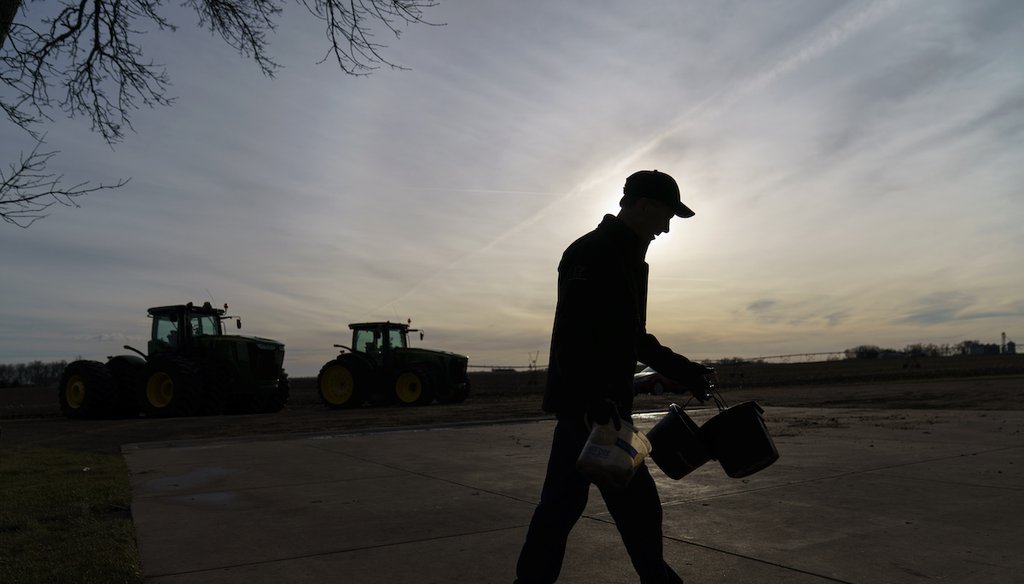



Al Saunders walks on his farm in Benson, Minn., in 2021. (AP)
Biden is correct about the decline in the number of U.S. farms over the past four decades, and he’s close on the acreage lost, which is roughly equal to the land area of the three states he cited.
Experts note that the definition of "farm" can be murky, encompassing everything from a major operation to a hobbyist project, and they add that this shrinkage masks improvements in agricultural efficiency.
President Joe Biden recently visited Minnesota farmland and touted how his economic policies are bolstering rural America.
Biden said fewer Americans are able to keep "the farm in the family," and, to emphasize his point, offered figures about the loss of agricultural land in recent decades.
"Over the past four decades, we’ve lost over 400,000 farms in America (and) over 140 million acres of farmland," Biden said Nov. 1. "And that’s an area roughly equal to the size of Minnesota, North and South Dakota combined."
That’s a lot of lost land. A reader heard his statistics and asked us to fact-check them.
We found the numbers are accurate, at least by one standard measure. But some agriculture experts caution against deciding that the news is dire.
The White House pointed us to data from the U.S. Department of Agriculture’s National Agricultural Statistics Service. According to that data, from 1982 to 2022, the number of U.S. farm operations fell from 2,406,550 to 2,002,700. That’s a decrease of 403,850 farms.
Over the same period, farm acreage fell from 1.027 billion acres to 893.4 million acres. That’s a decline of 134.4 million acres — less than what Biden said.
When we examined historical farm data, we found that the sharpest decline in farm operations occurred from the 1930s to the 1970s. During the period Biden cited, the number of farms has fallen, but more slowly.
To test Biden’s comparison with Minnesota and the Dakotas, we calculated the land area of all three states. (States also have water area, which is substantial for a Great Lakes state like Minnesota, so we removed water acreage from the calculation.)
The three states’ total land area is 137 million acres, close to the farm acreage lost between 1982 and 2022.
There is more than one source of data for measuring U.S. agriculture. Data from the U.S. Census Bureau, for instance, found smaller numbers for farms and acreage in 1982: 2.24 million farms and 986 million acres. This would make the decline of each of these metrics less steep than Biden indicated in his speech.
Also, there’s no consensus definition for "farm."
"The term ‘farm’ is fairly fluid," said Claire Strom, a historian who specializes in agriculture at Rollins College. "Does it include hobby farms? Market gardens? Not-for-profit organizations?"
President Joe Biden tours Dutch Creek Farms in Northfield, Minn., on Nov. 1, 2023. (AP)
Experts cautioned that numbers alone don’t tell the full story.
Nostalgia for the old-fashioned family farm is common, but experts said the inevitable march of technology and economics has pushed smaller operations aside and left fewer, larger operations.
"Farms probably will get larger and become fewer in number in the years ahead. This is not necessarily a problem," said R. Douglas Hurt, a Purdue University history professor who specializes in agriculture. "Small-scale family farms are not more economically viable or more moral than large corporate farms, most of which are family corporations for tax purposes."
According to the Agriculture Department, production of food and other agricultural products nearly tripled between 1948 and 2017. That means that even as the land and labor used in farming declined, "innovations in animal and crop genetics, chemicals, equipment and farm organization have enabled continuing growth in farm output," the department said.
And as fewer people are needed to produce the same number of farm goods, people have left rural areas. Population loss has gone hand in hand with technological advances that meant fewer people could produce the same, or larger, crops.
Jayson Lusk, a food and agricultural economist at Oklahoma State University, has written that in 1900, just less than 40% of the total U.S. population lived on farms, and 60% lived in rural areas. By the mid-2010s, about 1% lived on farms and 20% lived in rural areas.
"Young people leave the farm for better jobs and more money," Hurt said. "They have been doing this since the 1870s."
As farming becomes more efficient, more food can be made from less land, Strom said.
"I don’t know if I’d call that benign, as it requires greater inputs of chemicals and technology," Strom said. "However, I don’t see it as a result of greater outsourcing of food production or any deliberate effort to undermine the U.S. farmer."
Biden said, "Over the past four decades, we’ve lost over 400,000 farms in America (and) over 140 million acres of farmland. And that’s an area roughly equal to the size of Minnesota, North and South Dakota combined."
His numbers roughly track with legitimate data sources for farms, farmland and those three states.
However, the definition of "farm" can be murky, and the lost farmland masks improvements in efficiency that meant more goods could be farmed from less land by fewer people.
We rate the statement Mostly True.
Joe Biden, speech in Northfield, Minn., Nov. 1, 2023
Department of Agriculture National Agricultural Statistics Service, data, accessed Nov. 3, 2023
U.S. Census Bureau, data on farms, 1982
Agriculture Department, "A Look at Agricultural Productivity Growth in the United States, 1948-2017," March 5, 2020
Jayson Lusk, "The Evolution of American Agriculture," June 27, 2016
Email interview with Claire Strom, Rollins College history professor, Nov. 3, 2023
Email interview with R. Douglas Hurt, Purdue University history professor, Nov. 3, 2023
Email interview with Jeremy M. Edwards, White House spokesperson, Nov. 3, 2023
In a world of wild talk and fake news, help us stand up for the facts.
